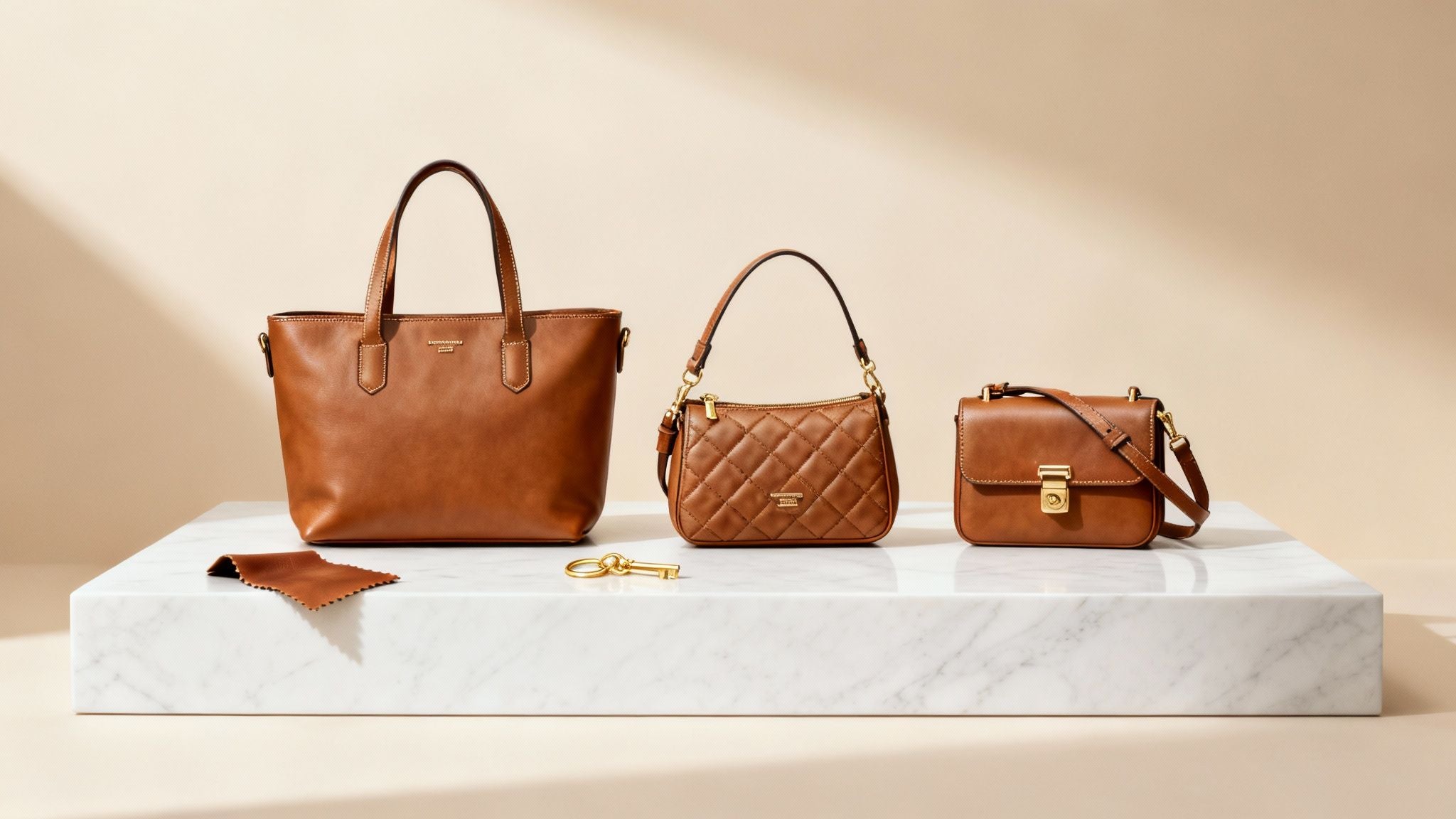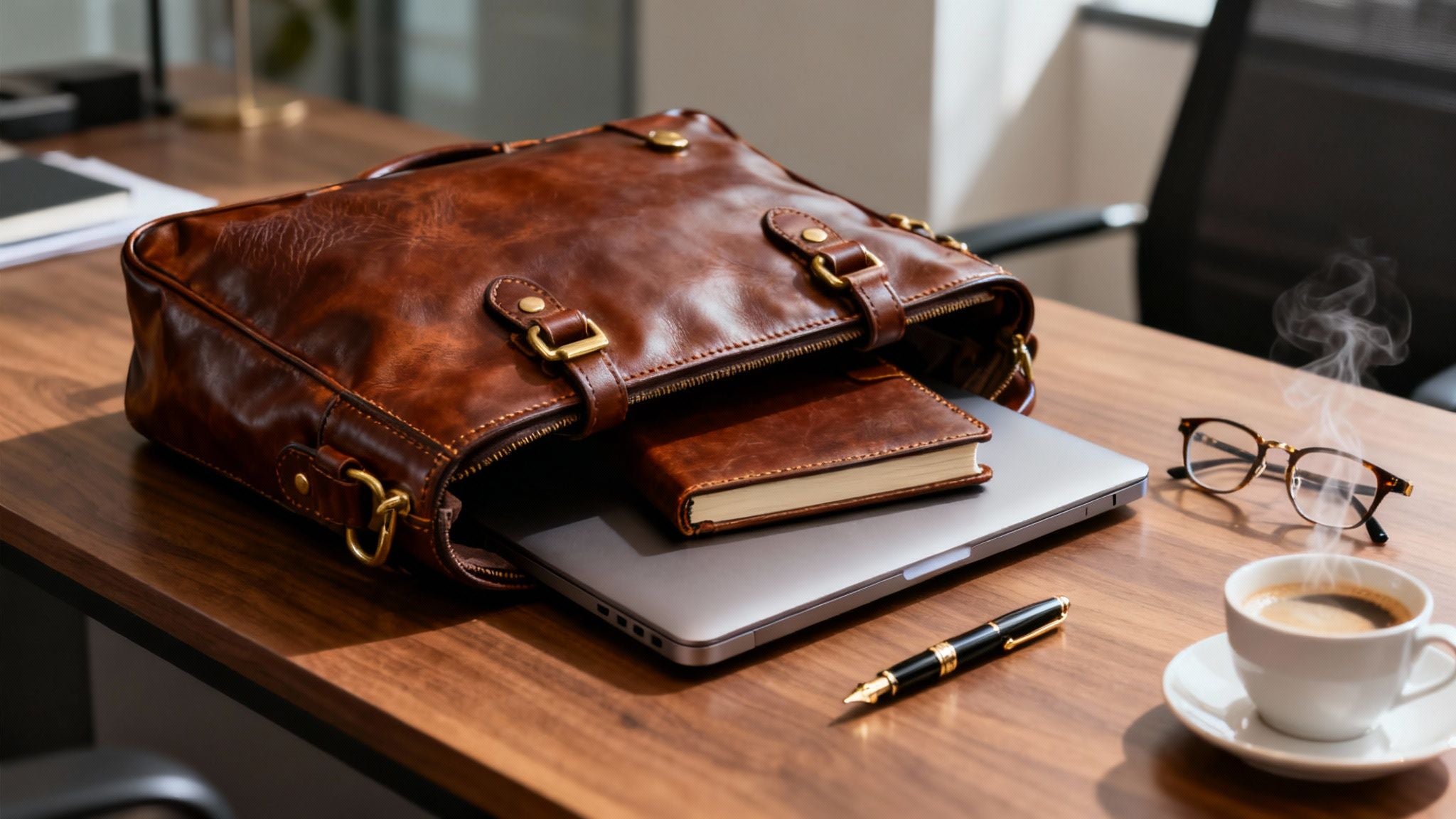how to clean a leather purse at home: Easy, Fast Guide
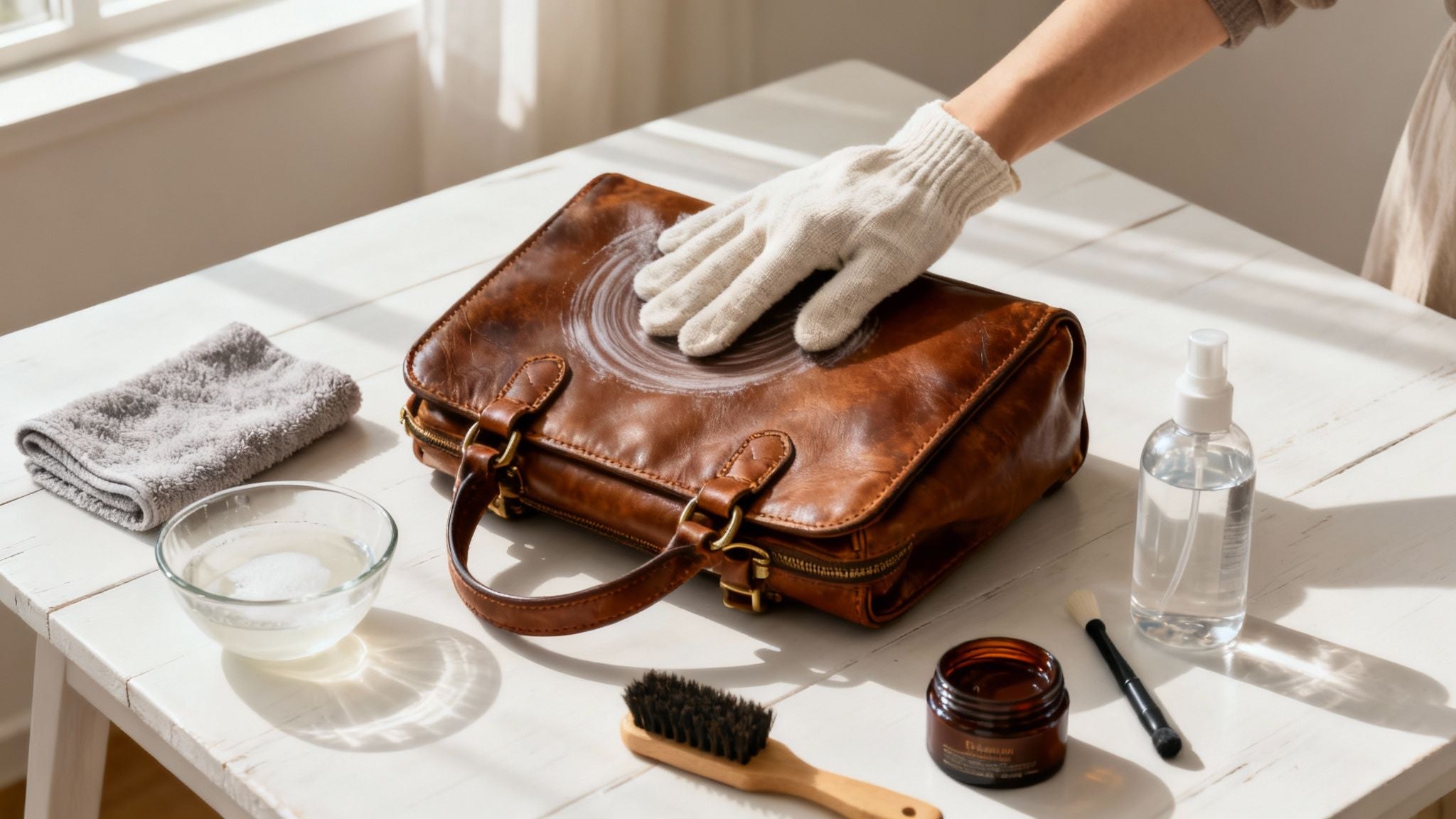
Alright, let’s bring that beautiful leather bag back to life. It's easier than you think.
For most common finished leathers, all you really need is a gentle mix of mild soap and distilled water. You’ll apply it with a damp microfiber cloth using soft, circular motions. But before you do anything, you must—and I mean must—do a quick spot test on a hidden part of the bag. This simple trick is your best defense against accidental damage.
Starting Your At-Home Leather Purse Rescue
Before you even grab a cloth, the most important thing you can do is get to know your bag. Think of yourself as a leather detective. You wouldn't treat a delicate silk scarf the same way you treat a rugged pair of jeans, right? The same logic applies here. Figuring out what kind of leather you're working with is the first, and most crucial, step in this whole process.
More and more people are realizing how important proper maintenance is. The leather care market is now a big deal, valued at around $800 million and growing by about 5% each year. It just goes to show that a little bit of care goes a long way in protecting an accessory you love.
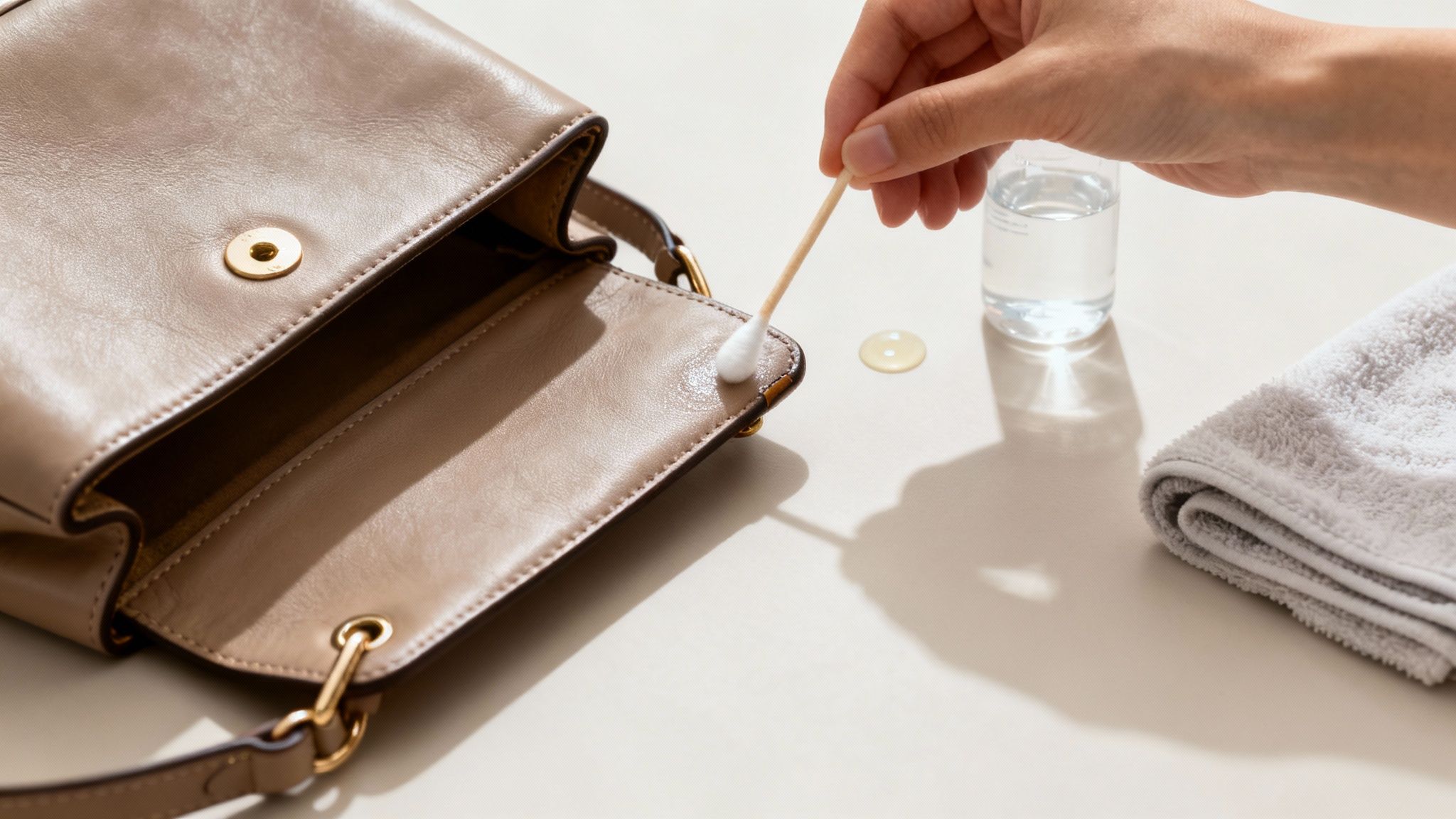
Before diving in, let's quickly review the tools you'll need. Having everything ready to go makes the process smooth and stress-free.
Quick Guide to Leather Purse Cleaning Supplies
| Item | Purpose | Recommended Type |
|---|---|---|
| Microfiber Cloths | Applying cleaner and buffing dry. | At least two; soft, non-abrasive. |
| Soft Brush | Loosening surface dirt and debris. | A horsehair or other soft-bristle brush. |
| Mild Soap | The cleaning agent for your solution. | A clear, dye-free liquid soap (e.g., gentle dish soap). |
| Distilled Water | Prevents mineral spots from tap water. | Available at any grocery store. |
| Leather Conditioner | To moisturize the leather after cleaning. | A reputable brand formulated for handbags. |
With these items on hand, you’re well-equipped for a successful cleaning session.
Identify Your Leather Type
First things first, you need to know if you're dealing with finished leather, unfinished (aniline) leather, or suede. The easiest way to tell is with a quick water test.
Find a hidden spot—like the underside of a flap or an interior seam—and place a single, tiny drop of water on it.
- If the drop beads up and sits on the surface, you’ve likely got finished leather. It has a protective coating, making it much easier to clean.
- If the water soaks in and darkens the spot almost immediately, it’s probably unfinished leather. This type is much more delicate and needs special care.
Understanding these differences is key. If you're unsure, our guide on how to tell if you have https://www.thebagicon.com/blogs/news/real-leather-womens-handbags can give you more pointers.
The Non-Negotiable Spot Test
I can't stress this enough: never, ever skip the spot test. Once you've mixed your cleaning solution, find that discreet area again and apply a very small amount. Let it sit and dry completely.
Key Takeaway: Look for any sign of trouble—darkening, discoloration, or a change in texture. If you see anything unusual, stop. That cleaner isn't right for your bag.
This one simple check takes maybe five minutes, but it can save you from a complete disaster. While leather is its own unique material, some of the same principles from basic upholstery cleaning and care tips apply here, especially when it comes to testing first to preserve the material's integrity.
Finally, get your purse prepped for its spa day. Empty out every single pocket and compartment—no exceptions! If you can, pull the lining inside out and go over it with a lint roller or the small brush attachment on your vacuum to suck up all those crumbs and bits of lint. Even just a good shake over the trash can will do wonders. This way, you’re starting with a clean slate instead of just moving dirt around.
Assembling Your Gentle Cleaning Toolkit
You don’t need an arsenal of professional supplies to give your leather purse the TLC it deserves. In my experience, the right tools are simple, but they make all the difference in protecting your investment. Think of this as putting together a personal spa kit for your favorite bag.
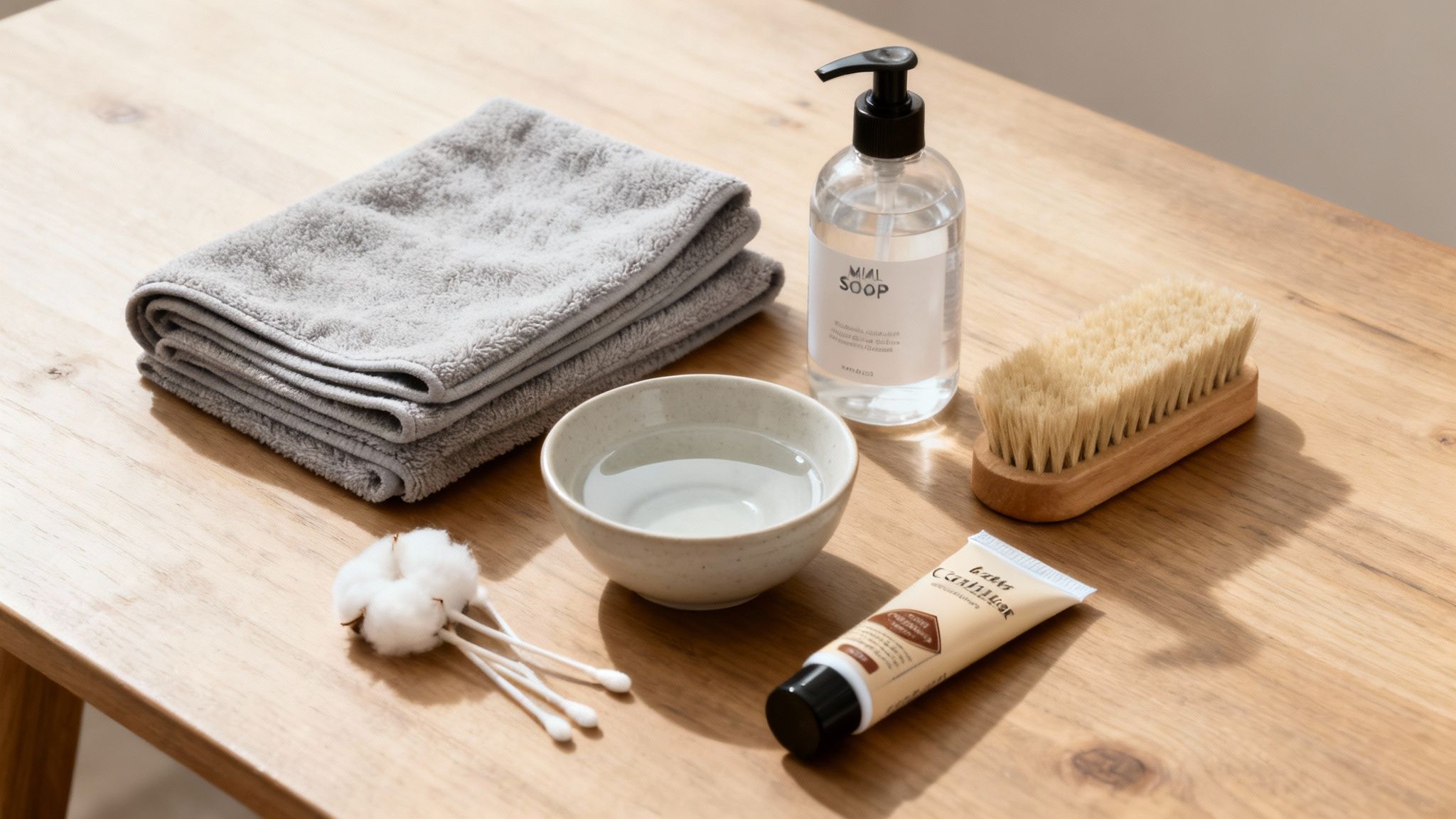
The single most important item here is a set of soft microfiber cloths. Their ultra-fine fibers are designed to lift dirt away without scratching the leather's surface. Please, stay away from paper towels or old t-shirts—they feel soft to us, but they're far too abrasive and can cause tiny scratches that dull the finish over time.
Choosing Your Cleaning Solution
When it comes to the actual cleaner, you have a couple of fantastic options, depending on what your bag needs and what you're comfortable with.
- A DIY Solution: For routine clean-ups on finished leather, a simple mix of a few drops of mild, clear liquid soap with distilled water is perfect. It's gentle, effective, and costs next to nothing.
- A Commercial Leather Cleaner: If you're dealing with tougher grime or a more delicate, unfinished leather, a professionally formulated cleaner is a much safer bet. These are specifically pH-balanced to clean thoroughly without stripping away the leather’s essential natural oils.
The demand for great home care products is surging, with the global leather care market expected to hit nearly USD 5.9 billion in the next decade. This is great news for us, as it means high-quality, safe options are easier to find than ever. You can read more about the leather care products market at Market.us.
Pro Tip: Never, ever use harsh chemicals like ammonia, bleach, or even baby wipes on your leather purse. They will absolutely dry out and permanently damage the material, leading to cracks and discoloration that can't be fixed.
Essential Finishing Touches
To really round out your toolkit, you'll need two more non-negotiable items.
First, a soft-bristled brush (a horsehair one is ideal) is invaluable. It’s perfect for gently whisking away dust and debris from textured leathers or getting into tight seams without causing any harm.
Finally, a high-quality leather conditioner is not optional—it's essential. The cleaning process, no matter how gentle, removes some of the leather's natural moisture. A good conditioner puts that moisture right back, keeping the material supple and preventing future cracks. This is the final step that truly restores your bag's health and brings back that beautiful luster.
Putting The Gentle Cleaning Method To Work
Alright, you’ve got your tools laid out and your bag is prepped and ready. Now for the main event—gently cleaning away the grime without harming the leather. The real secret here is in the technique, not brute force. Our goal is to lift the dirt without stripping away those natural oils that keep the leather supple.
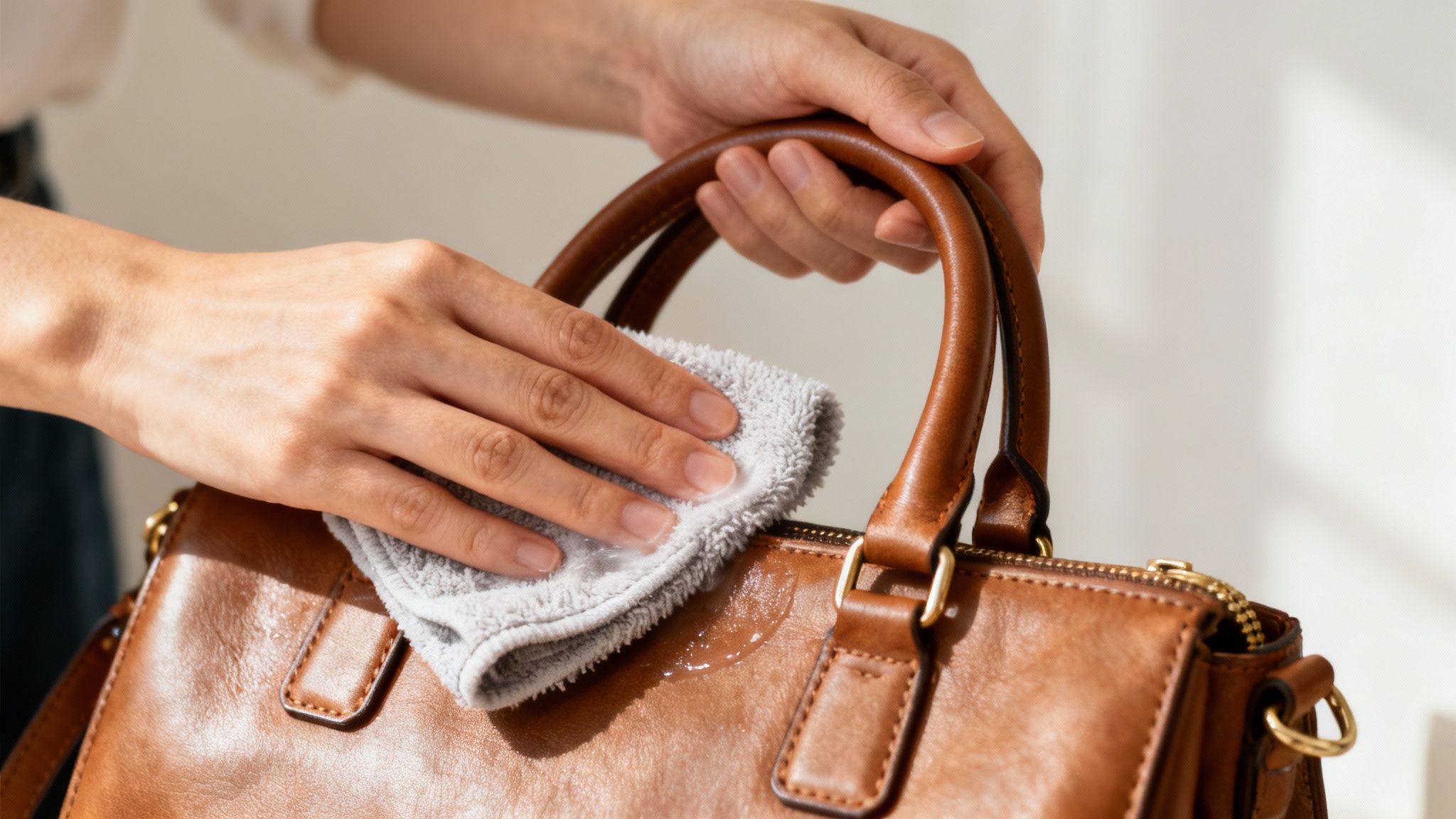
First things first, let's mix up our cleaning solution. In a small bowl of distilled water, add just a couple of drops of a mild, clear liquid soap. You’re looking for a very light, slightly sudsy mix. Trust me, less is always more when it comes to soap and leather.
Now, take a corner of your microfiber cloth and dip it into your solution. This next part is absolutely critical: wring it out until it’s barely damp. I mean it. The cloth shouldn't drip or even feel wet. Too much water is the fastest way to create stains and damage, and that’s the last thing we want.
Mastering Your Technique
With your dampened cloth in hand, start cleaning the outside of the purse. The trick is to use soft, circular motions, tackling one small area at a time. It's more like polishing a delicate apple than scrubbing a pot. This gentle movement helps pull dirt out of the leather’s grain without being harsh.
Be sure to give a little extra love to the high-traffic areas that collect the most dirt and oils:
- The handles and straps, which are constantly absorbing oils from our hands.
- The bottom corners, since they tend to get scuffed and set down on surfaces.
- The areas around hardware like zippers and clasps where dust loves to hide.
This careful approach isn't just for purses; it's a universal principle for leather care. In fact, you can see similar ideas in professional techniques for cleaning leather car interiors, where gentle application and moisture control are just as important.
A Pro Tip I Swear By: Always clean from the top of the bag down. This little habit keeps dirty suds from running over the sections you just cleaned, saving you the headache of redoing your work.
The Finishing Touches
Once you’ve given the entire surface a once-over, it's time for a quick "rinse." Grab your second clean, dry microfiber cloth and dampen it lightly with only distilled water. Wipe the whole bag down again to remove any soap residue, which can leave a dull film behind if left to dry.
And now, for the easiest—and hardest—part: letting it dry. Find a spot for your purse in a well-ventilated room, away from direct sunlight or heating vents. Under no circumstances should you use a hairdryer! The intense, direct heat will literally cook the moisture out of the leather, making it brittle and prone to cracking.
Give it a few hours, or even let it sit overnight. You'll know it's ready for the final conditioning step when it's completely and totally dry to the touch.
Handling Common Stains and Spills
Life happens, and sometimes it happens right on your favorite leather purse. But don’t panic. From a rogue pen mark to an accidental coffee splash, many common stains can be handled right at home with the right technique and just a little patience. The key is to act quickly and gently.
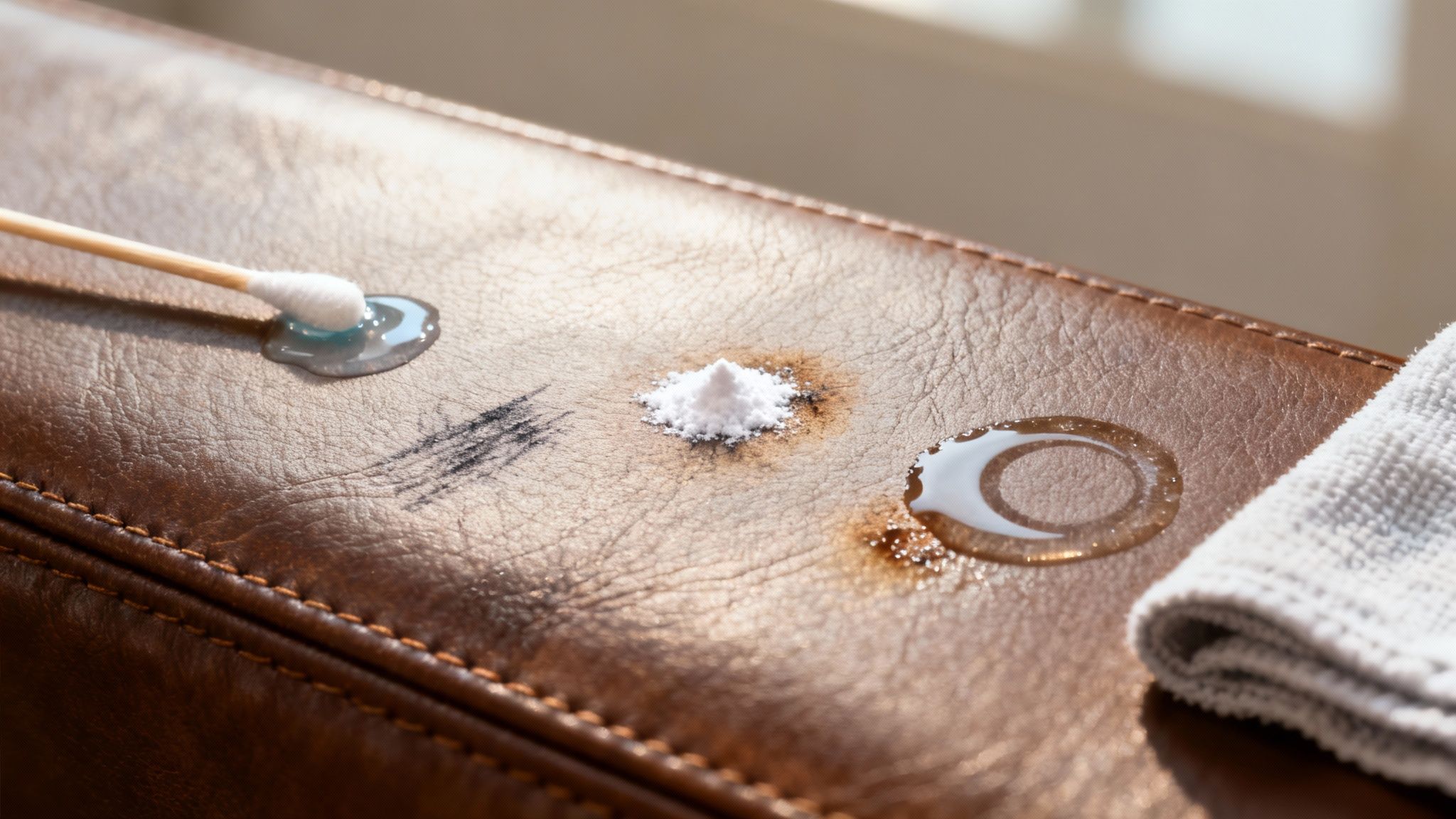
Before tackling any specific stain, always remember the golden rule: always spot-test your cleaning method on a hidden area first. A quick check on an inside seam or under a flap is your best insurance policy against making things worse, as what works for one type of leather might be too harsh for another.
Tackling Specific Purse Emergencies
Different spills call for different strategies. If you’re dealing with a fresh, greasy splotch—like a drop of salad dressing or lotion—your first move should be to absorb the oil, not rub it deeper into the material.
-
For Grease Stains: Immediately cover the spot with a generous layer of cornstarch or baking soda. Let it sit for several hours, or even overnight. The powder acts like a tiny sponge, pulling the grease out of the leather’s pores. The next day, you can just gently brush it all away with a soft brush.
-
For Ink Marks: That stray pen mark can feel like a disaster, but it’s often manageable. Dip a fresh cotton swab in rubbing alcohol and carefully dab the ink spot. Be sure to use a light, lifting motion to pull the ink up rather than spreading it around. Switch to a clean part of the swab for each dab to avoid reapplying the ink.
Key Insight: The number one trick to successful stain removal is to always blot, never rub. Rubbing a stain can force the pigment deeper into the leather's grain, making it a permanent part of your bag's design.
The growing demand for great maintenance solutions is why the leather care products market is expected to grow from USD 3.5 billion to over USD 5.3 billion in the coming years. This boom means more specialized and safer products are becoming available for you to use at home.
For more in-depth guidance on tackling all sorts of blemishes, be sure to check out our complete guide on how to remove stains from leather. With these targeted approaches, you can confidently handle minor accidents and keep your purse looking absolutely pristine.
Conditioning to Restore and Protect Your Purse
Getting your bag clean is really only half the job. Think of it like washing your hair—you’d never dream of skipping the conditioner, would you? The same idea applies perfectly to leather care. The cleaning process, even when you’re super gentle, can strip away some of the leather’s essential oils, leaving it feeling a bit dry and thirsty.
This final step is where the magic happens. It’s all about putting that life and moisture back into your purse. Skipping the conditioner is what eventually leads to that stiff feeling, a dull finish, and—worst of all—those awful cracks that can form along seams and handles over time. A quality leather conditioner works like a deep moisturizer, soaking into the pores to replenish everything the cleaning process took out.
By conditioning, you keep the material soft and supple, bring back that beautiful, rich luster, and add a much-needed layer of protection. This is what turns a quick clean-up into a genuine, long-term care routine.
How to Apply Conditioner Correctly
Applying conditioner is pretty straightforward, but your technique really does matter. The goal is a light, even coat that the leather can drink up completely without leaving a greasy or sticky residue behind.
Start by dabbing a small, coin-sized amount of conditioner onto a fresh, dry microfiber cloth. A key tip: never apply it directly onto the purse itself, as this can lead to dark spots or uneven absorption.
Using gentle, circular motions, work the conditioner into the leather just like you’d apply lotion. Give a little extra attention to the high-traffic areas that bend and flex a lot, such as the straps, corners, and the area around the clasps.
Important Takeaway: Once you've applied the conditioner, give it time to work its magic. Let it sit and fully absorb for at least 30 minutes (or whatever the product label suggests). After it's had time to sink in, grab a separate clean cloth and give the entire surface a light buff. This removes any excess product and brings out a gorgeous, healthy sheen.
Of course, using the right product is essential. To find the perfect conditioner for your specific type of bag, you’ll want to check out our detailed review of the best leather conditioner for handbags. For an extra layer of defense, you might also consider using a protectant spray to shield your freshly pampered purse from future spills and bad weather.
A Few Common Questions About Leather Care
Even after walking through the steps, it's natural to have a few questions bubble up, especially when you're working on a bag you love. Getting the right answers can give you the confidence to care for your purse properly. Let's clear up some of the most common things people ask.
How Often Should I Clean My Purse?
If you carry your bag every day, a quick wipe-down with a dry microfiber cloth once a week is a fantastic habit to get into. It’s a simple move that stops everyday dust and grime from building up.
For a more thorough clean, plan on giving it a full conditioning treatment every two to three months. And of course, if you notice a specific stain, it's best to tackle it right away. A little regular care goes a long way in preventing the leather from drying out and cracking over time.
Can I Use Common Household Cleaners?
This is a big one, and the answer is a definite no. Please don't reach for things like baby wipes, all-purpose sprays, or anything with harsh chemicals or alcohol. These products are way too aggressive for leather and can strip its natural finish, cause ugly discoloration, and lead to damage that you just can't undo.
Crucial Tip: Always, always stick to cleaners specifically formulated for leather or the gentle DIY mix of mild soap and distilled water. Using the wrong cleaner can turn a simple task into a disaster.
What Is the Best Way to Store a Leather Bag?
Storing your bag the right way is your best line of defense against dust, damage, and sad, saggy shapes. The dust bag that came with your purse is perfect, but a breathable cotton pillowcase works just as well. Just never store it in plastic—it traps moisture, which can lead to serious problems.
To help your bag keep its beautiful structure, gently stuff it with some acid-free tissue paper or even a small pillow. Find a spot for it on a shelf in a cool, dark closet, away from any direct sunlight that could fade its gorgeous color.
At The Bag Icon, we believe that a beautiful leather handbag is an investment worth protecting. Explore our collection of affordable luxury purses and find your next favorite accessory today. Visit us at https://www.thebagicon.com.
